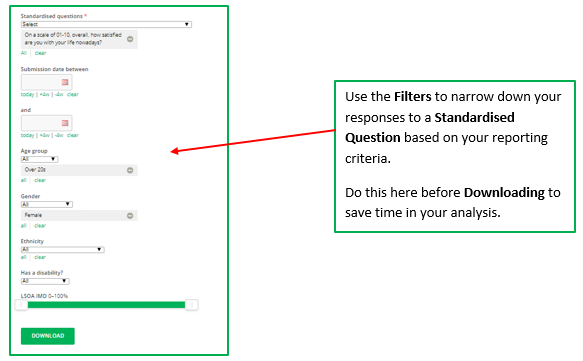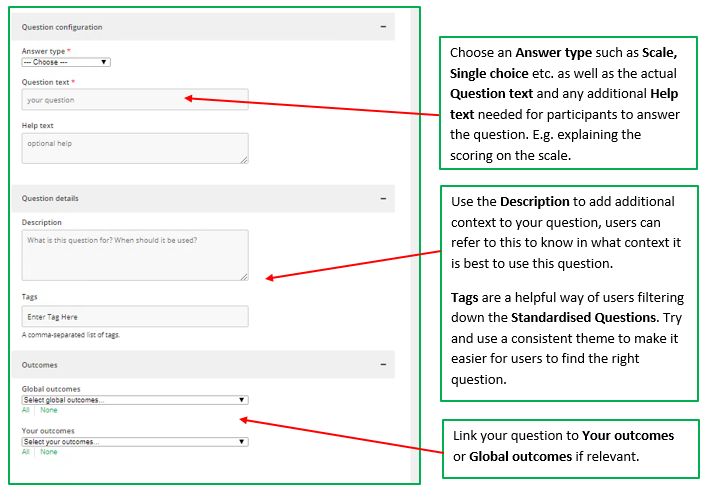Standardised Questions
When creating a survey, organisations can now create and use Standardised Questions. These can be created at both a Facilitating Organisation and Delivery Organisation level and can enhance survey reporting by including some participants' details alongside question responses.
In addition, by creating Standardised Questions this allows System Admins to create a library of questions their organisation can use when creating new surveys in the future. This cannot only save users time but also helps ensure consistency in the type of questions used across the organisation for reporting.
Organisations will also find some pre-built
Standardised Questions available under the heading of
Upshot Global Questions. These questions come from validated and
accredited surveys from the sector and can help ensure a consistent approach to measuring impact, rather than the need for organisations to create their own custom questions.
In addition, Facilitating Organisation accounts can now
Cascade Surveys down to relevant Delivery Organisations. This allows them to create and report on surveys directly that are completed by Delivery Organisation participants.
Using Standardised Questions
When creating a survey, users have the option to add various question types. They now have the option to Add a standardised question from the drop-down menu on the right.
This presents users with a list of different Standardised Questions. These include Upshot Global Questions bank and any Standardised Questions added by the organisation or its relevant Facilitating Organisation account.
To find relevant questions for your survey this can be filtered down by questions linked to Global Outcomes, Your outcomes and Tags.

Tags on questions from the Upshot Global Questions bank have been organised into Category and Survey to allow you to filter and find questions as needed, such as questions from Survey – WHO (Five) Well-being Index for example.
Note: Questions appear in alphabetical order in the drop-down list, rather than the particular order they appear in a certain survey.
When a Standardised Question has been added to the survey it cannot be edited, but it can be made required by the organisation if desired.

Surveys can contain all Standardised Questions or a mix of these and other question types. Note that the enhanced reporting will only be available on Standardised Questions.
To find out more about
Creating Surveys please click
here.
Reporting on Standardised Questions
Users can report on Standardised Questions in two ways.
- By reporting on these questions as part of the wider surveys they have been used in. For more detail see the Reporting on Surveys guide.
- By reporting on specific Standardised Questions by going to Report > Standardised Questions.
Within Report > Standardised Questions users can download all responses to one or more questions to analyse. Before downloading there are a variety of filters that can be chosen from to show only participant responses based on criteria such as Submission date, Age group, Gender, Ethnicity, Has a disability? and LSOA IMD.

The downloaded report will contain the responses to all questions selected and include the Gender, Age Group, Ethnicity, IMD %, Has a disability? and any Custom Attendee Fields. With the Question response featuring furthest to the right-hand side.
This can then be analysed to find patterns in question responses based on participants details. To aid this it might be helpful to use filters on Excel or
PivotTables.
Note: The Standardised Question report export will not contain the answers to Standardised Questions used in 'Anonymous' surveys.
Additionally, for Facilitating Organisations, the export will not include responses from Delivery Organisation 'users' only their 'attendees' to Standardised Questions. It will also include all responses from Delivery Organisation attendees to Standardised Questions regardless of whether they have attended related programmes.
Creating your own Standardised Questions
System Admins can create their own Standardised Questions. This can be completed by going to Admin > Standardised Questions.
This page will list all the existing Standardised Questions available to the organisation. It will also provide more details on each of these questions such as Answer type, Description, Tags, and any Global/Organisation outcomes this question is linked to. It will also detail if the Standardised Question is from Upshot Global Question bank or from the Facilitating Organisation.
To create a new Standardised Question click on Add Standardised Question.
From here, detail the Question configuration, Question details and any Outcomes this question should be linked to.
Remember that creating relevant tags or linking to relevant outcomes will make it easier to find your question when creating a survey.

For any existing Standardised Questions shared into the account organisations can add their own tags and outcomes to these, to help with their own reporting.
This can be completed by System Admins and can be done by going to Admin > Standardised Questions.
For any 'shared' questions there will be the option to 'customise' listed beneath the name of the question.
Delivery Organisations will be able to do this for questions shared from any Facilitating Organisations connected to their account or questions available from the Upshot Global Question bank.
Facilitating Organisations will be able to do this for questions available from the Upshot Global Question bank.
Key Terms
Standardised Questions:
Standardised questions are survey questions that can be used to enhance the reporting available to organisations when used. Standardised questions include Upshot Global Questions, a mix of accredited survey questions and one from large funders in the sector. Organisations can also create their own Standardised Questions.
Surveys:
Surveys can be created on the system and assigned to individual profiles. These can then be sent out to individuals via email or they can be completed by a system user on the individual’s behalf if they have a paper copy in front of them. Surveys could include a onetime evaluation form or a questionnaire that is completed at various points in time by individuals to measure changes in their responses. For more information on this please refer to the
Sending and Completing Surveys and
Comparing Surveys guides.



